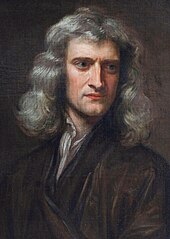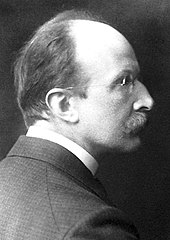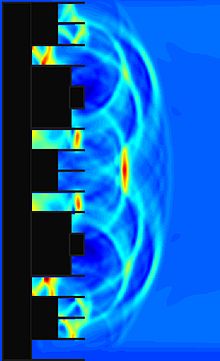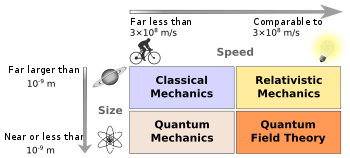Physics
Physics
Physics (from Ancient Greek: φυσική (ἐπιστήμη) phusikḗ (epistḗmē) "knowledge of nature", from φύσις phúsis "nature"[1][2][3]) is the natural science that involves the study of matter[4] and its motion and behavior through space and time, along with related concepts such as energy and force.[5] One of the most fundamental scientific disciplines, the main goal of physics is to understand how the universe behaves.[a][6][7][8]
Physics is one of the oldest academic disciplines, perhaps the oldest through its inclusion of astronomy.[9] Over the last two millennia, physics was a part of natural philosophy along with chemistry, biology, and certain branches of mathematics, but during the scientific revolution in the 17th century, the natural sciences emerged as unique research programs in their own right.[b] Physics intersects with many interdisciplinary areas of research, such as biophysics and quantum chemistry, and the boundaries of physics are not rigidly defined. New ideas in physics often explain the fundamental mechanisms of other sciences[6] while opening new avenues of research in areas such as mathematics and philosophy.
Physics also makes significant contributions through advances in new technologies that arise from theoretical breakthroughs. For example, advances in the understanding of electromagnetism or nuclear physics led directly to the development of new products that have dramatically transformed modern-day society, such as television, computers, domestic appliances, and nuclear weapons;[6] advances in thermodynamics led to the development of industrialization, and advances in mechanics inspired the development of calculus.
Classical physics
Physics became a separate science when early modern Europeans used experimental and quantitative methods to discover what are now considered to be the laws of physics.[18][page needed]
Major developments in this period include the replacement of the geocentric model of the solar system with the heliocentric Copernican model, the laws governing the motion of planetary bodies determined by Johannes Kepler between 1609 and 1619, pioneering work on telescopes and observational astronomy by Galileo Galilei in the 16th and 17th Centuries, and Isaac Newton's discovery and unification of the laws of motion and universal gravitation that would come to bear his name.[19] Newton also developed calculus,[c] the mathematical study of change, which provided new mathematical methods for solving physical problems.[20]
The discovery of new laws in thermodynamics, chemistry, and electromagnetics resulted from greater research efforts during the Industrial Revolution as energy needs increased.[21] The laws comprising classical physics remain very widely used for objects on everyday scales travelling at non-relativistic speeds, since they provide a very close approximation in such situations, and theories such as quantum mechanics and the theory of relativity simplify to their classical equivalents at such scales. However, inaccuracies in classical mechanics for very small objects and very high velocities led to the development of modern physics in the 20th century.
Modern physics
Modern physics began in the early 20th century with the work of Max Planck in quantum theory and Albert Einstein's theory of relativity. Both of these theories came about due to inaccuracies in classical mechanics in certain situations. Classical mechanics predicted a varying speed of light, which could not be resolved with the constant speed predicted by Maxwell's equations of electromagnetism; this discrepancy was corrected by Einstein's theory of special relativity, which replaced classical mechanics for fast-moving bodies and allowed for a constant speed of light.[22] Black body radiation provided another problem for classical physics, which was corrected when Planck proposed that the excitation of material oscillators is possible only in discrete steps proportional to their frequency; this, along with the photoelectric effect and a complete theory predicting discrete energy levels of electron orbitals, led to the theory of quantum mechanics taking over from classical physics at very small scales.[23]
Quantum mechanics would come to be pioneered by Werner Heisenberg, Erwin Schrödinger and Paul Dirac.[23] From this early work, and work in related fields, the Standard Model of particle physics was derived.[24] Following the discovery of a particle with properties consistent with the Higgs boson at CERN in 2012,[25] all fundamental particles predicted by the standard model, and no others, appear to exist; however, physics beyond the Standard Model, with theories such as supersymmetry, is an active area of research.[26] Areas of mathematics in general are important to this field, such as the study of probabilities and groups.
Classical physics
Classical physics includes the traditional branches and topics that were recognised and well-developed before the beginning of the 20th century—classical mechanics, acoustics, optics, thermodynamics, and electromagnetism. Classical mechanics is concerned with bodies acted on by forces and bodies in motion and may be divided into statics (study of the forces on a body or bodies not subject to an acceleration), kinematics (study of motion without regard to its causes), and dynamics (study of motion and the forces that affect it); mechanics may also be divided into solid mechanics and fluid mechanics (known together as continuum mechanics), the latter include such branches as hydrostatics, hydrodynamics, aerodynamics, and pneumatics. Acoustics is the study of how sound is produced, controlled, transmitted and received.[37] Important modern branches of acoustics include ultrasonics, the study of sound waves of very high frequency beyond the range of human hearing; bioacoustics, the physics of animal calls and hearing,[38] and electroacoustics, the manipulation of audible sound waves using electronics.[39]
Optics, the study of light, is concerned not only with visible light but also with infrared and ultraviolet radiation, which exhibit all of the phenomena of visible light except visibility, e.g., reflection, refraction, interference, diffraction, dispersion, and polarization of light. Heat is a form of energy, the internal energy possessed by the particles of which a substance is composed; thermodynamics deals with the relationships between heat and other forms of energy. Electricity and magnetism have been studied as a single branch of physics since the intimate connection between them was discovered in the early 19th century; an electric current gives rise to a magnetic field, and a changing magnetic field induces an electric current. Electrostatics deals with electric charges at rest, electrodynamics with moving charges, and magnetostatics with magnetic poles at rest.
Modern physics
| Modern physics |
|---|
Classical physics is generally concerned with matter and energy on the normal scale of observation, while much of modern physics is concerned with the behavior of matter and energy under extreme conditions or on a very large or very small scale. For example, atomic and nuclear physics studies matter on the smallest scale at which chemical elements can be identified. The physics of elementary particles is on an even smaller scale since it is concerned with the most basic units of matter; this branch of physics is also known as high-energy physics because of the extremely high energies necessary to produce many types of particles in particle accelerators. On this scale, ordinary, commonsense notions of space, time, matter, and energy are no longer valid.[40]
The two chief theories of modern physics present a different picture of the concepts of space, time, and matter from that presented by classical physics. Classical mechanics approximates nature as continuous, while quantum theory is concerned with the discrete nature of many phenomena at the atomic and subatomic level and with the complementary aspects of particles and waves in the description of such phenomena. The theory of relativity is concerned with the description of phenomena that take place in a frame of reference that is in motion with respect to an observer; the special theory of relativity is concerned with relative uniform motion in a straight line and the general theory of relativity with accelerated motion and its connection with gravitation. Both quantum theory and the theory of relativity find applications in all areas of modern physics.[41]
Difference between classical and modern physics
While physics aims to discover universal laws, its theories lie in explicit domains of applicability. Loosely speaking, the laws of classical physics accurately describe systems whose important length scales are greater than the atomic scale and whose motions are much slower than the speed of light. Outside of this domain, observations do not match predictions provided by classical mechanics. Albert Einstein contributed the framework of special relativity, which replaced notions of absolute time and space with spacetime and allowed an accurate description of systems whose components have speeds approaching the speed of light. Max Planck, Erwin Schrödinger, and others introduced quantum mechanics, a probabilistic notion of particles and interactions that allowed an accurate description of atomic and subatomic scales. Later, quantum field theory unified quantum mechanics and special relativity. General relativity allowed for a dynamical, curved spacetime, with which highly massive systems and the large-scale structure of the universe can be well-described. General relativity has not yet been unified with the other fundamental descriptions; several candidate theories of quantum gravity are being developed.








Comments
Post a Comment